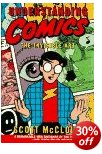reflections on hypertext and story-telling
Janet Murray has an intellectual background which will be common to many who have passed through higher education since the 1960s. She is rooted in her training in the humanities (English Literature) – but she has been touched by developments in computer science, and wishes to combine the two disciplines. She holds simultaneously a deep reverence for post-Renaissance book-based traditional learning and an appreciation that digitised texts, non-sequential narratives, and multimedia effects might produce new artistic forms. Hamlet on the Holodeck is an exploration of what has been done to develop these new forms – and what might be done in the future. It is a study which has become a central text in the required reading on hypertext. As a teacher at the Massachusetts Institute of Technology – the home of research and development in multimedia – she knows the field well.
 Her examination starts with a survey of science fiction and various modern narratives which explore the possibilities of parallel universes or alternative realities – including 3-D movies and virtual reality simulators. She describes the existing technology with enthusiasm – although in each case she ends up in the realm of ‘Imagine if this could be put to use in …’ rather than what has been done. But this is understandable. After all, we are considering an extremely new technology. When printing was first invented, books were produced which imitated written manuscripts, just as in our own age cinema and radio first imitated the live theatre. Maybe the new digital narrative forms have not yet emerged.
Her examination starts with a survey of science fiction and various modern narratives which explore the possibilities of parallel universes or alternative realities – including 3-D movies and virtual reality simulators. She describes the existing technology with enthusiasm – although in each case she ends up in the realm of ‘Imagine if this could be put to use in …’ rather than what has been done. But this is understandable. After all, we are considering an extremely new technology. When printing was first invented, books were produced which imitated written manuscripts, just as in our own age cinema and radio first imitated the live theatre. Maybe the new digital narrative forms have not yet emerged.
She discusses videogames, virtual dungeons (MUDs and MOOs) and literary hypertexts, including the best known – Michael Joyce’s Afternoon and Stuart Moulthrop’s Victory Garden. She also considers the advantages and weaknesses of Web-based narrative experiments. These include the complex worlds which are generated around TV soap operas for instance – which have archives of back footage linked to fan-generated materials.
The main problem is that she doesn’t really confront the most fundamental philosophical principle of fictional narratives. This is that consumers usually want and appreciate a series of events which has been artfully conceived and structured by somebody else. Such narratives represent, in no matter how diffuse a form, a distinctive point of view or perspective on the world.
There is much discussion of journeys through mazes, fantasy quests, dragon-slaying, and all the usual clichés of games with names such as Pong, Zork, and Doom. However, when it comes to predicting what the new forms might be, these tend to be simply different ways of telling the same story – multiple viewpoints – a strategy which has been adopted in most art forms, and which is not intrinsically connected to computers or hypertext. Her arguments and exposition seem more fruitful when she is discussing the rapidly merging world of the Web and television.
Her examination of current multimedia productions is wide-ranging and thorough, although there are one or two assumptions about what is likely to develop which seem open to question. The first is that computers will somehow participate in the generation of basic narratives. The second is that readers will be invited to participate in the story. The third is that a video games or MUDs are likely to be the most likely form to be developed. These are certainly interesting possibilities, but whether they are necessary elements of the new forms or not, only convincing evidence will tell.
However, these are reservations of a rather theoretical nature. At a practical level, anyone interested in the future possibilities of story-telling using computer technology should read this book. Its comprehensive survey of current practice is an inspiring starting point for what might be achieved in the digital future.
© Roy Johnson 2001
Janet H. Murray, Hamlet on the Holodeck, Cambridge, MA: MIT Press, 1999, pp.324, ISBN: 0262631873
More on digital media
More on technology
More on theory


